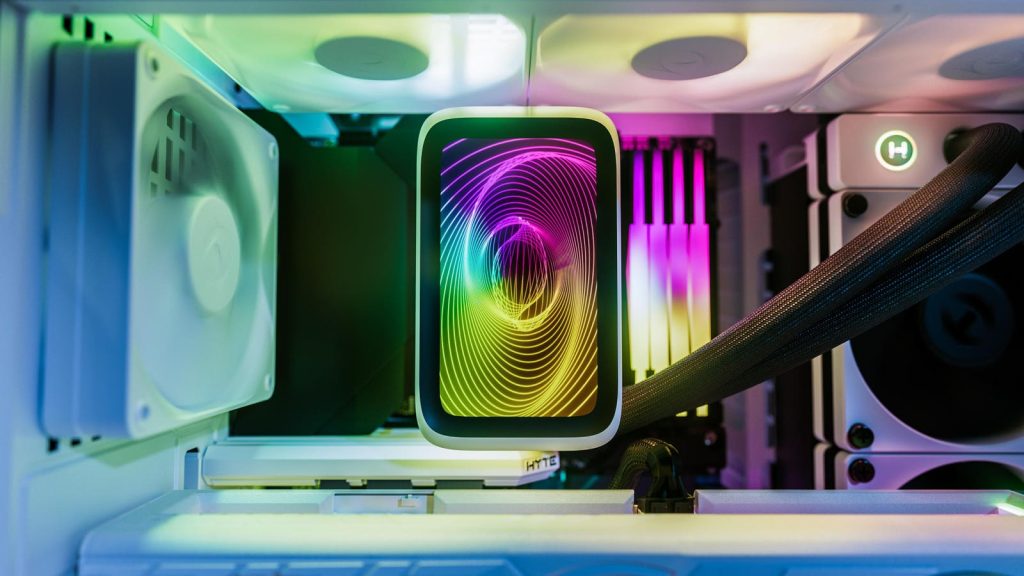If your PC case doesn’t have enough room for larger processor liquid coolers then the HYTE THICC Q60 could be what you’re looking for. It’s an oversized 240 liquid cooler that only needs two 120mm fan mounts to house it, rather than three with larger coolers. This means it could be perfect for getting top-tier processor cooling in a smaller PC.
Both the THICC Q60’s fans and radiator are much thicker than normal liquid coolers. The thicker radiator means there’s more surface area across the fins inside it, allowing for greater heat transfer and potentially better cooling. That extra thickness comes at a cost, though, which is a need for more powerful fans. You can see my video review below to see if it’s the best liquid cooler out there.
The deeper the radiator, the more restrictive it is in terms of getting air through it at a fast enough rate. Thinner radiators are much easier to deal with, but if you add thicker, more powerful fans into the mix, you can solve that problem. That’s what HYTE has done here too. In addition to a 52mm-thick radiator (around 20mm thicker than normal models), it includes 32mm-thick fans, while normal PC fans are just 25mm thick, providing more shove in terms of airflow.
The HTYE Q60 doesn’t stop there though. It has a large, high resolution screen that can display a range of graphics including system temperatures and other animations. Incredibly, the screen is powered by a quad-core processor and 2GB of DDR4 memory. It looks fantastic, but undoubtedly adds to the coolers hefty price tag of $299, which is a lot for a 240mm liquid cooler. The screen also means it’s also unlikely to fit in many small form factor cases, which is a shame as it could have offered exceptional cooling in those small spaces.
It also has two coolant pumps that are located in the radiator and as you’d expect, it’s compatible with current and previous processor sockets from Intel and AMD such as the Ryzen 9 7800X3D or Core i9-14900K . The large radiator is easy to install, but you’ll need to make sure you have space for its 288mm length and 84mm depth with fans installed.
The screen, pumps and fans are controlled using software and this was quite detailed, presenting a relatively steep learning curve and it can take a while to set everything up. But you get excellent control over the fan and pump speeds and can tie them to a variety of temperature sources.
Out of the box those speeds are tied to the liquid temperature, which results in a quieter cooler as it takes the coolant a while to heat up with little to impact on the processor temperature to some extent.
Some screen display features aren’t available yet, but you’re able to pick from various graphics and backgrounds using the software, including hardware or coolant temperatures.
Cooling tests
I used a Core i7-14700K running at stock speed to compare the coolers in the graph below and ran the Cinebench 10 minute stress test, taking the average P-core temperature after that time using CoreTemp.
Above we can see the cooling performance sorted by temperature and the HYTE THICC Q60 liquid cooler managed to keep up with the massive Thermaltake TH420 V2 ARGB, which has three 140mm fans and a much larger radiator than the HYTE cooler. It was also much better at cooling than the MSI MAG Coreliquid E240, which is a standard-size liquid cooler so its bigger fans and radiator certainly seem to make a difference.
Above the same results are now sorted by noise level and the HYTE THICC Q60 can be tuned to be extremely quiet with the lowest sound readings. However, the lower fan speeds also resulted in much higher temperatures as the fans struggled to push enough air through the large radiator.
Conclusions
It’s very well made and you won’t see much better cooling performance from any other liquid cooler on the market and the HYTE’s THICC Q60 can also be tuned to be very quiet too. You have to watch how slow you tune the fans, though, as the default settings can result in high CPU temperatures, but the software, while a tad clunky and complicated, does allow for excellent control if you like tinkering.
Accepting the price, though, is a tougher ask as it’s clear you can get better cooling for less money with larger radiators and the fact it’s large screen makes it unsuitable for a lot of small form factor cases, limits its appeal which is a shame. It looks fantastic and it’s cooling is spectacular, but the $300 price tag means only PC builders with sizeable budgets who don’t have the space or desire for custom liquid cooling should consider it.
Read the full article here









